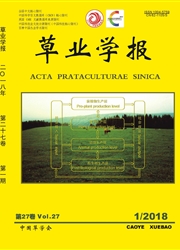

 中文摘要:
中文摘要:
采用人工践踏法对人工建植4年后的沟叶结缕草草坪进行不践踏(对照)、轻度、中度和重度4种践踏胁迫处理,研究了不同践踏胁迫下的部分坪用性状及其自然恢复能力,为沟叶结缕草草坪的建植、管理和养护提供理论依据与实践参考。结果表明,不同践踏胁迫将显著降低沟叶结缕草草坪的坪用性状,不同性状间的效应为草层高度〉盖度〉密度〉地上部生物量〉倒3叶长。不同践踏胁迫对各坪用性状的影响存在显著差异,适度践踏可控制草层高度,降低生物量,增加草坪密度。经过53d的自然恢复,被践踏草坪能获得一定程度的恢复,但恢复的优劣与坪用性状和践踏强度相关。恢复后的草坪密度高于践踏前的水平,恢复效果为中度〉轻度〉重度,但均极显著小于对照;草层高度和盖度能恢复到践踏前的水平,以中度践踏后恢复最好;倒3叶长可恢复到践踏前的86.8%~93.5%,且极显著高于对照。中度践踏的地上部生物量能恢复至践踏前的90.2%,轻度和重度践踏后可恢复至践踏前的115.0%以上,但均极显著低于对照。因此,轻度践踏对草坪的伤害较小并可较快自然恢复至原状,中度践踏对草坪产生短时的较重伤害但能较慢地恢复至原状,而重度践踏对草坪的伤害较大和影响较长则难以自然恢复至原状。
 英文摘要:
英文摘要:
Zoysia matrella possesses the characteristics of developed aboveground stolon and underground rhizomes, long and thin leaves, long green periods, intensive grass sward, strong reproduction and resistance, and low maintenance costs so it is the most important warm season turfgrass in the south of China and the first option for planting sports and urban open turf. From previous literature, the research on Z. matrella was more focused on the morphological and anatomical structures, drought, cold, saline and alkaline resistances, but there were few studies on trampling tolerance and natural recovery after trampling was seriously neglected. To provide some theoretical basis and practical references for the planting, management and maintenance of Z. metrella turf, the effects of various trampling stresses, including none (control), light, moderate and heavy trampling on the characteristics of Z. rnetrella turf established for 4 years and their natural recovery were studied using artificial trampling. All trampling stresses significantly reduced turf characteristics in the order of turf height〉turf coverage〉turf density〉aboveground biomass〉length of the top third leaf. The effects of various trampling stresses on the turf characteristics were obviously different and moderate trampling could control turf height, decrease turf biomass and increase turf density. After 53 days of natural recovery, the trampled turfs gained some recovery, but the consequence of recovery was related to the turf characteristics and trampling intensity. Turf height after recovery was higher than that before trampling in the order of moderate trampling〉 light trampling〉heavy trampling and was extremely significantly lower than that of the control. Turf height and coverage could recover to the original level before trampling and was best with moderate trampling. The length of the top third leaf could recover to 86.8 %- 93.5 % of the original level and was extremely significantly higher than that of the control. The aboveground bi
 同期刊论文项目
同期刊论文项目
 同项目期刊论文
同项目期刊论文
 期刊信息
期刊信息
